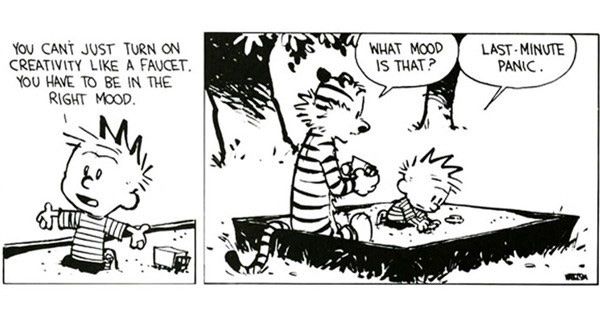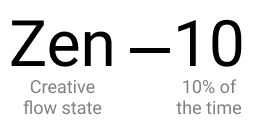
Many organizations treat the concept of creativity (or, innovation, out-of-the-box thinking, ideation, etc.) as if it were a genie in a bottle. When there are moments of real need, we grab the bottle from the supply closet, pack into the conference room, rub it carefully, and eagerly await the resulting brilliance. Sometimes the genie comes, but most times it doesn’t.
My guess is that this “genie in a bottle” approach stems from the strong ethos in society around inspiration — that of a brilliant spark that once captured, “just needs to be built.” Whereas in my experience, the most creative output comes from a much tighter connection between ideation and execution. As you start building and the thing begins taking shape, it inspires, it frustrates, it demands creative adjustments.
I've seen various approaches to giving employees creative space – some successful, some not – but my favorite is a concept my team called Zen-10.

This is a variation on the almost mythical twenty percent time concept from Google. For the unaware, the idea was that any Google employee could spend twenty percent of their working time on “whatever they wanted.” Sadly for Google (and perhaps the rest of us), the idea doesn’t appear to have stuck:
“I’ve got to tell you the dirty little secret of Google’s 20% time. It’s really 120% time.” — Marissa Mayer (an early Google employee)
This sentiment mirrors stories from many folks, at Google and other places that have tried it: because there is no explicit time set aside for this program, the onslaught of “real work” quickly eats away at this “optional work” time.
The term zen-10, coined by my friend and colleague Stephen Swensen, speaks directly to how the concept is different from the Google concept: zen — a state of calm attentiveness in which one’s actions are guided by intuition rather than by conscious effort, and 10 —as in, ten percent of a person’s work time. In short — less, but more spacious, time allotted.
For each member of our team, every other Thursday was their zen-10 day, when they would spend the full day completely disconnected from the realities of work life — no “assigned” work, no meetings, no expectation to be available via chat or on-call. That time was set aside for them to learn new things, scratch itches, experiment, and dream. The only two rules were that they had to:
- Work on something loosely related to the business
- Share whatever they did the next day at our team sharing meeting
The result was a resounding and sustained success. As a manager, I had stumbled upon a way to create legitimate time and space for team members to get into a flow in order to express themselves and grow, and in a way that was predictable and easy to plan around. And the team repaid me in spades by creating and sharing wonderful things.
Zen-10 projects were numerous and diverse. Some focused on personal growth, learning, and researching. Some involved scratching longstanding itches by fixing a bug, or investing in infrastructure improvements. And a surprising number of them significantly pushed the envelope of our thinking on what our business could become. Though it was clear that people shouldn’t expect their projects to become part of the roadmap, a decent number of them ultimately did.
All in all, not only had the zen-10 process created a framework for encouraging ongoing creativity and growth, it somewhat paradoxically helped the team become more productive than before (i.e. more was getting done in their 90% time than previously in their 100% time), in part because of the output of the 10% time itself, and in part because the team seemed happier and more engaged. Some tactical things we learned that made it work:
- A full uninterrupted day was important to allow for zen-like flow.
- The cadence was staggered — half the team this week, the other half the next, and so on —keeping momentum high for zen-10 and “regular” work.
- The groups were chosen deliberately in order to ensure no gaps in coverage for project work, on-call schedules, important meetings, etc.
- Having it on the same day each week made it much easier to plan around.
- Multiple people doing it at the same time encouraged collaboration.
- Keeping it “loosely related” to the biz kept it productive but not stifling.
- The expectation of demoing *something* helped encourage iterative work.
- 10% was just right — fits into existing project schedule and allows for zen.
- Coupling it with a #zen-10 slack channel allowed people to post quick ideas, share results, and gather feedback during their 90% time.
Compared to a variation we tried whereby the team had a zen-10-like week each quarter, we found that the steady drumbeat of weekly creative output was more impactful to the business and more fulfilling to our team members.
It's been neat to see other teams adopt the zen-10 concept over the past few years, but as with all ideas concerning people and process, your mileage may vary. Setting aside the specifics, I think that the broader lesson learned is widely applicable: a culture of creativity requires continual nurturing.
Furthermore, as project deadlines get tight, products flounder, and the competition breathes down our neck, the natural inclination is to tighten our grip on the proverbial wheel by forcing more rigidity and top-down decision making. In my experience, it’s often these times when it’s most important to relax our grip because it’s when we need our team to be at their healthiest, and their work to be at its most creative.



